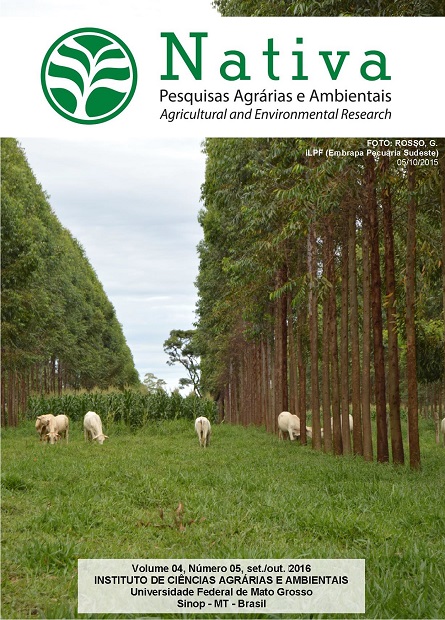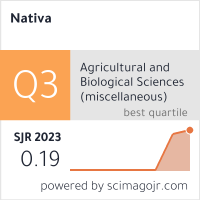COLORIMETRY AND SURFACE ROUGHNESS OF THREE AMAZON WOODS SUBMITTED TO NATURAL WEATHERING
DOI:
https://doi.org/10.31413/nativa.v4i5.3426Resumo
COLORIMETRIA E RUGOSIDADE SUPERFICIAL DE TRÊS MADEIRAS AMAZÔNICAS SUBMETIDAS AO INTEMPERISMO NATURAL
This study aimed to evaluate the color and surface roughness of the wood of three Amazonian species submitted to natural weathering. For this purpose, samples of Apuleia leiocarpa (Vogel) J. F. Macbr., Erisma uncinatum Warm and Parkia pendula (Willd.) Benth. ex Walp., with dimensions of 1 x 2 x 30 cm (thickness, width and length, respectively), were exposed to natural weathering without contact with the soil for 240 days. The colorimetric characterization was performed by means of a colorimeter, and the parameters were L*, a*, b*, C*, h and ∆E. The roughness was determined with the aid of a profilometer of surface roughness, and the parameters Ra, Rz and Rt were evaluated. The wood exposed to natural weathering presented darkened (grayish color) surface, resulting from the reduction of colorimetric parameters L*, a* and b*. The Parkia pendula wood presented the greatest total variation of color in comparison to Apuleia leiocarpa and Erisma uncinatum. The parameters Ra, Rz and Rt showed an increase during the time of exposure of the woods to the natural weathering, in which Erisma uncinatum wood presented the roughest surface in comparison to the other species.
Palavras-chave: ensaio de campo, deterioração da madeira, madeira tropical, qualidade da madeira.
ABSTRACT
This study aimed to evaluate the color and surface roughness of the wood of three Amazonian species submitted to natural weathering. For this purpose, samples of Apuleia leiocarpa (Vogel) J. F. Macbr., Erisma uncinatum Warm and Parkia pendula (Willd.) Benth. ex Walp., with dimensions of 1 x 2 x 30 cm (thickness, width and length, respectively), were exposed to natural weathering without contact with the soil for 240 days. The colorimetric characterization was performed by means of a colorimeter, and the parameters were L*, a*, b*, C*, h and ∆E. The roughness was determined with the aid of a profilometer of surface roughness, and the parameters Ra, Rz and Rt were evaluated. The wood exposed to natural weathering presented darkened (grayish color) surface, resulting from the reduction of colorimetric parameters L*, a* and b*. The Parkia pendula wood presented the greatest total variation of color in comparison to Apuleia leiocarpa and Erisma uncinatum. The parameters Ra, Rz and Rt showed an increase during the time of exposure of the woods to the natural weathering, in which Erisma uncinatum wood presented the roughest surface in comparison to the other species.
Keywords: field trial, deterioration of wood, tropical wood, wood quality.
Referências
AMERICAN SOCIETY FOR TESTING AND MATERIALS – ASTM. D 2244: Standard practice for calculation of color tolerances and color differences from instrumentally measured color coordinates. ASTM International: West Conshohocken, 2009. 11p.
AMORIM, M.R.S. Agrupamento de espécies madeireiras amazônicas para a produção de painéis de lâminas paralelas (LVL). 2013. 103f. Dissertação (Mestrado em Ciências Florestais) - Universidade de Brasília, Brasília, 2013.
BARRETO, C.C.K.; PASTORE, T.C.M. Resistência ao intemperismo artificial de quatro madeiras tropicais: o efeito dos extrativos. Ciência Florestal, Santa Maria, v.19, n.1, p.23-30, 2009
CADEMARTORI, P.H.G.; et al. Natural weathering performance of three fast-growing eucalypt woods. Maderas. Ciencia y tecnologia, Concepción, v.17, n.4, p.799-808, 2015
COSTA, J.A.; GONÇALEZ, J.C.; CAMARGOS, J.A.A.; GOMES, I.A.S. Fotodegradação de duas espécies de madeiras tropicais: jatobá (Hymenaea courbaril) e tauari (Couratari oblongifolia) Submetidas à radiação ultravioleta. Cerne, Lavras, v.17, n.1, p.133-139, 2011.
FEIST, W.C. Weathering of wood in structural uses. In: MEYER, R.W.; KELLOGG, R.M. (Ed.). Structural use of wood in adverse environments. New York: Van
Nostrand Reinhold Co., 1982. p.156-178.
FEIST, W.C.; HON, D.N.S. Chemistry of weathering and protection. In: ROWELL, R.M. (Ed.). The chemistry of solid wood. Washington: Am. Chem. Soc, 1984. p.401-451.
HON, D.N.S. Weathering and photochemistry of wood. In: HON, D.N.S.; SHIRAISHI, N. (Ed.). Wood and cellulosic chemistry. 2.ed. New York: Marcel Dekker, 2001. p.513-546.
JAPANESE INDUSTRIAL STANDARD – JIS. B 0601: Geometrical Products Specifications (GPS) – Surface texture: Profile method – Terms, definitions and surface texture parameters. JIS: Tokyo, 2001. 27p.
MARTINS, S.; et al. Envelhecimento artificial acelerado por radiação ultravioleta de madeiras de Eucalyptus benthamii e Pinus caribaea var. hondurensis. Floresta, Curitiba, v.41, n.1, p.87-96, 2011.
PASTORE, T.C.M.; et al. Efeito do intemperismo artificial em quatro madeiras tropicais monitorado por espectroscopia de infravermelho (DRIFT). Química Nova, São Paulo, v.31, n.8, p.2071-2075, 2008.
SANTANA, M.A.E.; OKINO, E.Y.A. Chemical composition of 36 Brazilian Amazon forest wood species. Holzforschung, Berlin, v.61, n.5, p.469-477, 2007.
SILVA, J.O.; PASTORE, T.C.M. Fotodecomposição e proteção de madeiras tropicais. Floresta e Ambiente, Seropédica, v.21, n.2, p.7-13, 2004.
SILVA, J.O.; PASTORE, T.C.M.; PASTORE JÚNIOR, F. Resistência ao intemperismo artificial de cinco madeiras tropicais e de dois produtos de acabamento. Ciência Florestal, Santa Maria, v.17, n.1, p.17-23, 2007.
TEMIZ, A.; et al. Surface roughness and color characteristics of wood treated with preservatives after accelerated weathering test. Applied Surface Science, v. 250, n.1-4, p.35-42, 2005.
TELES, R.F.; COSTA, A.F. Influência do intemperismo acelerado nas propriedades colorimétricas da madeira de angelim pedra. Nativa, Sinop, v.2, n.2, p.65-70, 2014.
THOMA, H.; PERI, L.; LATO, E. Evaluation of wood surface roughness depending on species characteristics. Maderas. Ciencia y Tecnologia, Concepción, v.17, n.2, p.285-292, 2015.
TOLVAJ, L.; MITSUI, K. Correlation between hue angle and lightness of light irradiated wood. Polymer Degradation and Stability, v.95, n.4, p.638-642, 2010.
TOLVAJ, L.; MOLNAR, Z.; MAGOSS, E. Measurement of photodegradation-caused roughness of wood using a new optical method. Journal of Photochemistry and Photobiology B: Biology, v.134, p.23-26, 2014.
TURKOGLU, T.; BAYSAL, E.; TOKER, H. The effects of natural weathering on color stability of impregnated and varnished wood materials. Advances in Materials Science and Engineering, v.2015, Article ID 526570, p.1-9, 2015.
WILLIAMS, R.S. Weathering of wood. In: ROWELL, R.M. (Ed.) Handbook of wood chemistry and wood composites, Boca Raton: CRC Press, 2005. p.139-185.
WILLIAMS, R.S.; et al. Erosion rates of wood during natural weathering: Part III. Effect of exposure angle on erosion rate. Wood and Fiber Science, Hanover, v.33, n.1, p.50–57, 2001.
Downloads
Publicado
Edição
Seção
Como Citar
Licença
Direitos Autorais para artigos publicados nesta revista são do autor, com direitos de primeira publicação para a revista. Em virtude de a aparecerem nesta revista de acesso público, os artigos são de uso gratuito, com atribuições próprias, em aplicações educacionais e não-comerciais.
A artigos publicados nessa revista, podem ser reproduzidos parcialmente ou utilizados como referência por outros autores, desde que seja cita a fonte, ou seja, a Revista Nativa.
Copyright for articles published in this journal are the authors, with first publication rights granted to the journal. The journal shows open access, and articles are free to use, with proper attribution, in educational and non-commercial.
The articles published in this journal may be reproduced in part or used as a reference by other authors, provided that the source is quoted.






